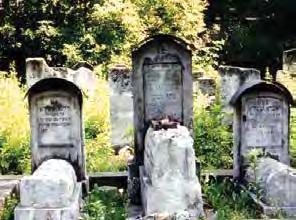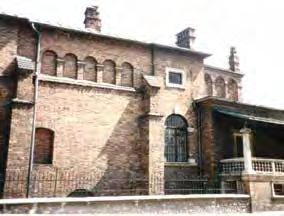
8 minute read
The Wandering Jew
The Wandering Jew Siyum in Lublin
Part II
In the ohel of the Rebbe Rav Meilech in Lizensk L-R: Rabbis Yaakov Finkelstein, Yitzchok Aron Fischer, Chaskel Besser, Michael Schudrich, and Yossel Schiff surrounding the baal bris The kevorim of the Megale Amukos and family in Krakow


Our arrival in Poland in the summer of 1995 was only thirty hours ago, and yet we accomplished so much of our intended itinerary.
We arrived in Warsaw, davened at the kivrei tzaddikim at the bais olam, heard a lecture at the Jewish museum, went to the Umshlagplatz and the Ghetto Memorial, and visited the Nozyk Shul. We traveled to Gura Kalwaria, davened in the Gerrer Bais Medrash, and visited the ohel of the first two Gerrer Rebbes. The next morning, we walked through the old bais hachaim of Lublin and were exposed to the horrors of Treblinka. The main feature and purpose of our trip was to bring our group of twenty esteemed guests to the Siyum HaDaf at the Yeshiva of Lublin. This event was the true highlight of the first thirty hours. The siyum, the speeches, the singing and dancing of about one hundred Yidden – mostly locals –gave proof that the “pintele Yid” was still alive, even in Poland. It was evidence that Rabbi Meyer Shapiro’s dream had an effect on so many Jews worldwide.
Late Wednesday afternoon, our guests boarded the coach bus, and we continued our journey. Our next destination was Lizensk to be mispallel at the kever of the Rebbe, Reb Meilech. Thousands of Yidden make this pilgrimage for the Rebbe’s yahrtzeit on the 21st of Adar, and we were very inspired to say Tehillim and leave kvitlech by his kever.
From there, I took our group to see a most unusual synagogue in the town of Lancut. The multicolored walls, ceilings, bimah, and aron kodesh are a feast for one’s eyes. I was also instrumental many years earlier to help with the restoration work of the over-forty panels of tefillos and kapitlach Tehillim that grace all the walls. We also went to kever of the Ropshitzer Rebbe, which is at the town’s edge. From there, we traveled to Rzeszow (Reisha), where we said tefillos by the kevorim of the Bluzhever Rebbes. I told them the story how my friend Itchie Friedman and I merited to build the ohel over their graves. Then we settled back for the two-hour ride to Krakow.
When we arrived, we davened Maariv in the pitch dark Izaac Yekeles Shul, where I related the history of the magnificent building and the circumstances that led to its construction. We had dinner in the brand new Nissenbaum Kosher Restaurant with an excellent hashgacha. We could barely keep our eyes open as we headed to our rooms at the Hotel Forum on the Wisla River. It was an extremely long day, and tomorrow would be even longer.
Thursday early in the morning, we were privileged to attend two brissim which took place at the youth club. One was for a young man going through geirus and the other bris was for a Jewish baby. Then we rushed over to daven in the Remah Shul and toured the Old Bais HaChaim behind the Shul. The kevorim of some our greatest rabbis are located here. Besides the Remah and his family, the Bach, the Rebbe Rav Heschel, the Megaleh Amukos, Maginei Shlomo and the Tosvos Yom Tov are some of the more noted personalities interred in this holy place. Then we walked around the streets of Kazimierz, the Jewish sector of Krakow, and visited some of remaining shuls which are now tourist attractions. Walking in the footsteps of our gedolim was a major draw for our esteemed group who appreciated the historical significance of this neighborhood.
From this special high, we descended to the lowest moment of our recent history as we entered Auschwitz. Our guide brought to life what happened in




Auschwitz In the Ohel of the Rebbe Rav Meilech in Lizensk At the kevorim of the Bluzhever Rebbes in Rzeszow

this work camp and contrasted it to what happened in the neighboring death camp pf Birkenau. We saw the bunkers, the gas chambers, and the crematoria and were physically and mentally broken at the horror that met our eyes. We walked from building to building silently in utter shock. With the exception of the heartfelt Kaddish that was recited, we could not utter a word. What is there to say?
From this low point, we ascended to a glimmer of hope for the future. We drove over two hours to join the participants of the Ronald Lauder retreat in the Beskid mountains of Southern Poland under the leadership of Rabbi Michael Schudrich. There, we joined over one hundred Polish Jews who were rediscovering their history and heritage. Our group met the participants at the retreat where Pesi and I went every summer to give lectures and to demonstrate the vitality and beauty of Yiddishkeit. The singing at the tables and all the voices that joined in Birchas Hamazon were evidence that “Netzach Yisroel lo yeshaker.” There were speeches to introduce the guests to the retreat and its goals. There were music and dancing, which lifted our spirits after the destruction that we witnessed. We returned to Krakow near midnight, incredibly tired but on an enormous high.
On Friday, we began our day with a tour of the new bais hachaim led by Henryk Halkowski. I met Henryk in the late ‘70s and was always impressed with his knowledge of both Jewish tradition and history. Krakow, his hometown, was his specialty, and this tour added so many dimensions to our visit to the kivrei tzaddikim and even secular personalities at that cemetery.
Although it was Friday, it was summer, and Shabbos would not begin until after 7 PM. I felt that our visitors would be interested in seeing something out of the ordinary. So, I scheduled a trip to the Wieliczka Salt Mines, less than an hour drive from Krakow. When we descended nine flights of stairs to the heart of a cavity created through the extraction of salt, we entered into an underground art museum. All the artistic wall murals, statues, and reliefs were made of salt.
Salt was an important commodity, especially at a time that it served as a preservative of foodstuffs like meat, fish, and vegetables, when there was no refrigeration. After extracting salt for usage, artisans would form the layers of remaining salt on the walls into unbelievable works of art. Knowing from prior visits that many of the objects de art were religious in nature, I arranged with our guide that he would only stop and give a commentary at artworks that were not religious in nature. On our way out, we passed an enormous chamber with a huge chandelier made out of salt crystal. It was a stunning finale to our tour. I was criticized by one person about the fact that the chamber was, in fact, a chapel and he was uncomfortable having to pass through it. I explained that we were in the rear of the room and there was no way to exit other than through that room. Despite my explanation, he was still upset.
Friday afternoon was free time. Some people went to Nowy Sanz to the kever of the Sanzer Rebbe, the Divrei Chaim. Others joined Pesi and me, as we headed to the Sukenica, the famed Renaissance-era Cloth Hall which had dozens of vendors indoors, selling Polish handicrafts, jewelry, tablecloths, and other tourist souvenirs. It is very exciting and colorful, and for Americans, the prices were very cheap.
We rushed back to the hotel where we reserved the entire pool for our Erev Shabbos mikvah. We davened and had our inspiring Shabbos seuda at the hotel with zemiros and divrei Torah and stories relating to Krakow. Shabbos morning, we walked together and davened at the Remah Shul. Our seudah was in the kosher restaurant after which Henryk walked the group over to see the building of Sarah Schenirer’s first Bais Yaakov school. The rest of Shabbos we spent at the hotel davening and eating shalosh seudos together.
The final meal of Shabbos always has a certain melancholy feeling to it. The end of Shabbos leaves us with a sadness and a yearning for it to continue. Saying our goodbyes to our fellow travel-mates left us with the same feelings. The last six days we were one and we were united, and now we would become separated and everyone will be on their own. The only thing that will still unify us, we understood, will be our collective memories of this beautiful journey.
Hershel Lieber has been involved in kiruv activities for over 30 years. As a founding member of the Vaad L’Hatzolas Nidchei Yisroel he has traveled with his wife, Pesi, to the Soviet Union during the harsh years of the Communist regimes to advance Yiddishkeit. He has spearheaded a yeshiva in the city of Kishinev that had 12 successful years with many students making Torah their way of life. In Poland, he lectured in the summers at the Ronald S. Lauder Foundation camp for nearly 30 years. He still travels to Warsaw every year – since 1979 – to be the chazzan for Rosh Hashana and Yom Kippur for the Jews there. Together with Pesi, he organized and led trips to Europe on behalf of Gateways and Aish Hatorah for college students finding their paths to Jewish identity. His passion for travel has taken them to many interesting places and afforded them unique experiences. Their open home gave them opportunities to meet and develop relationships with a variety of people. Hershel’s column will appear in The Jewish Home on a bi-weekly basis.












